Just how quickly has the Vietnamese capital stock grown over the past decade ?
We use a detailed growth accounting method to estimate the annual growth rate of the aggregate
Vietnamese capital stock over the period 1996-2005. Our results show that the rate was likely to
have been in the vicinity of 7-8 % per annum. This is approximately 2 percentage points lower
than estimates appearing in some previous studies.
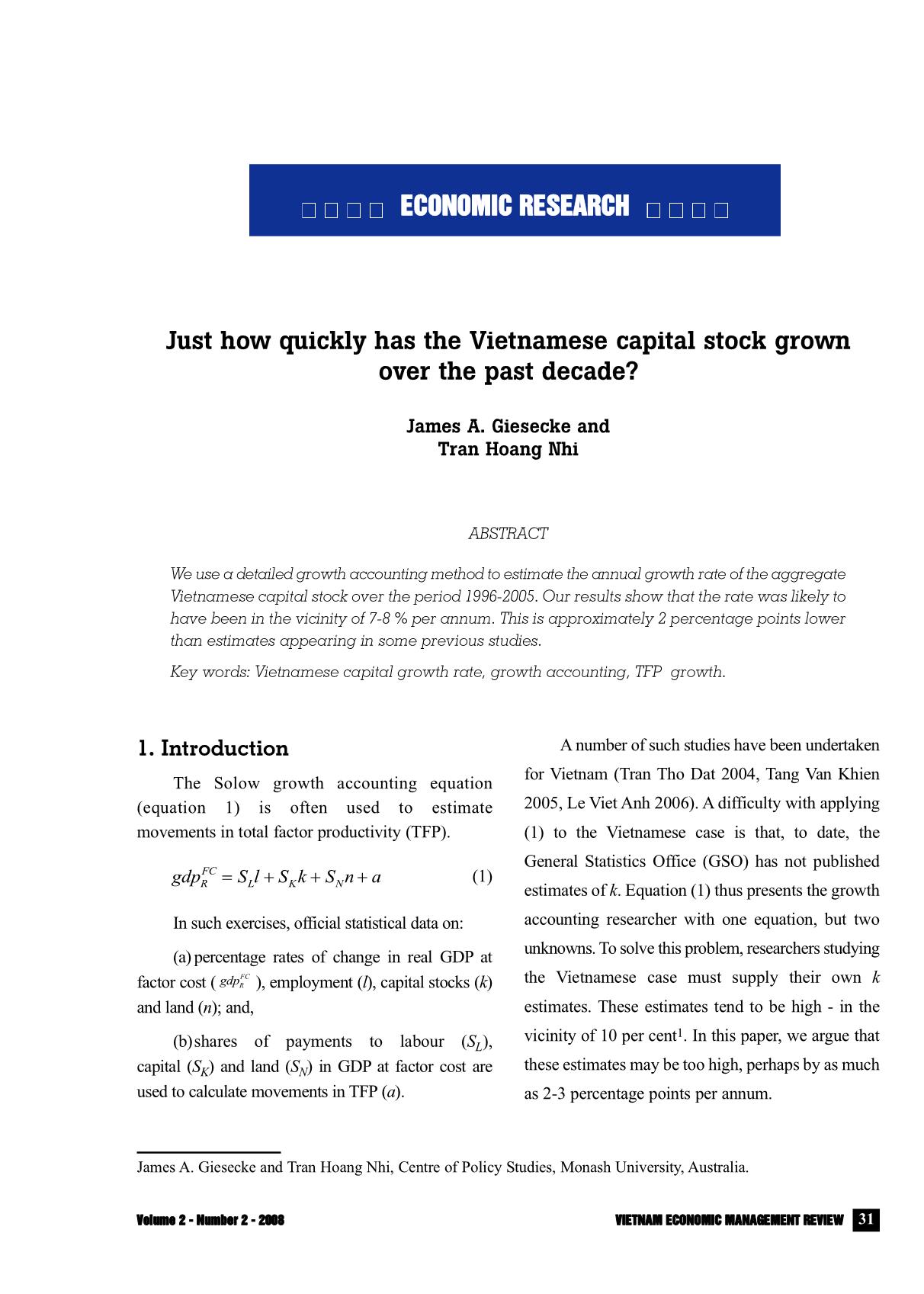
Trang 1
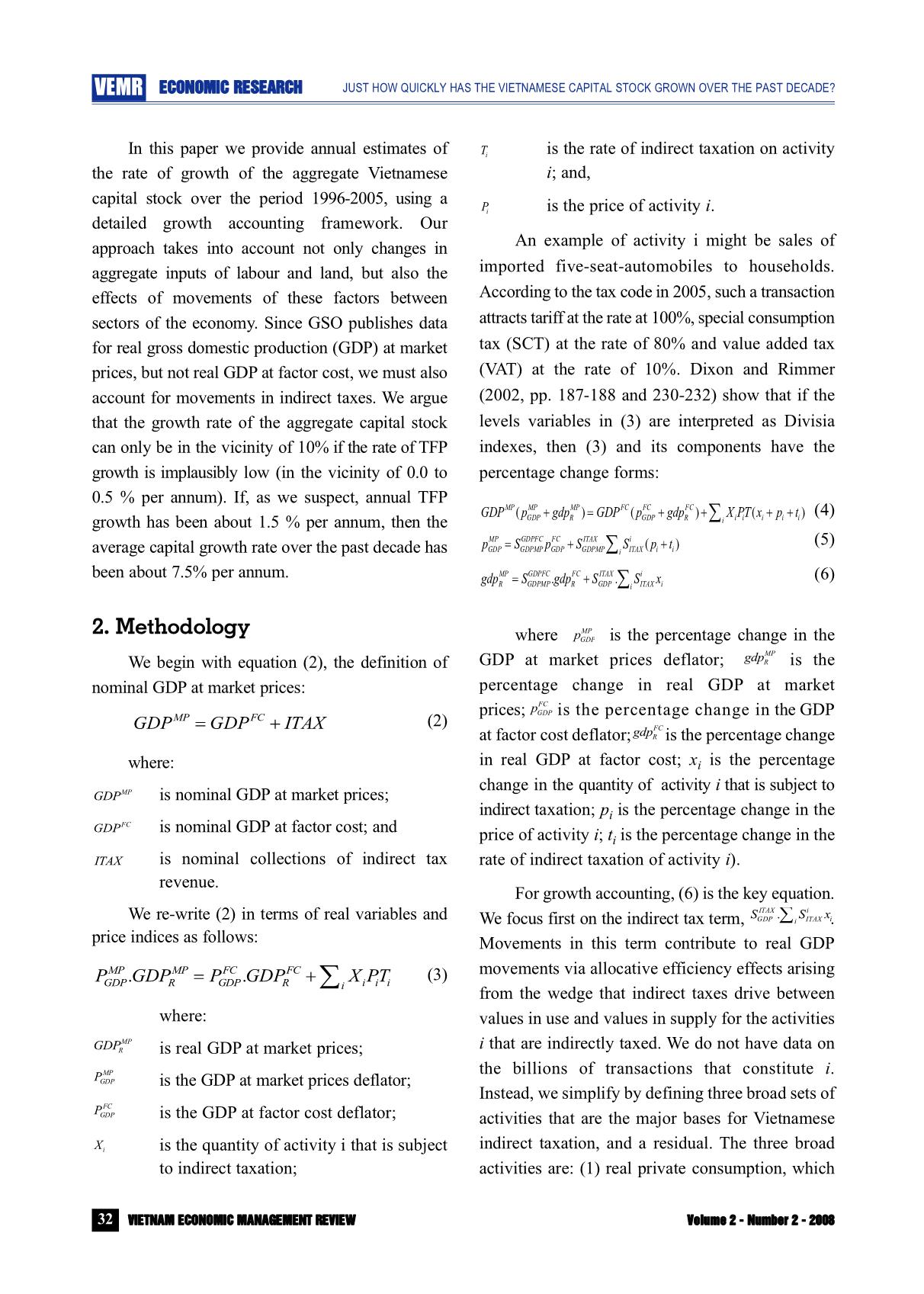
Trang 2
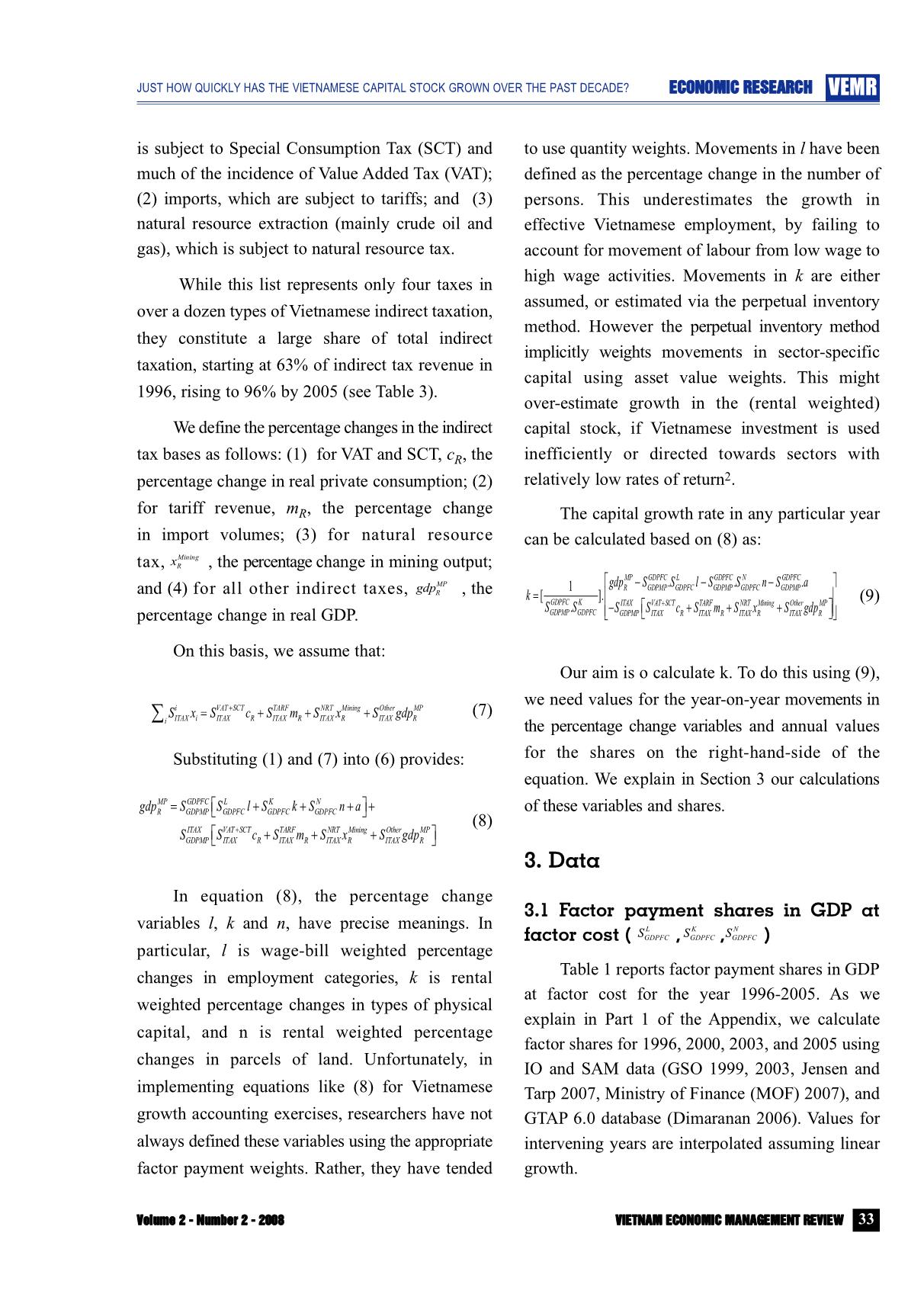
Trang 3
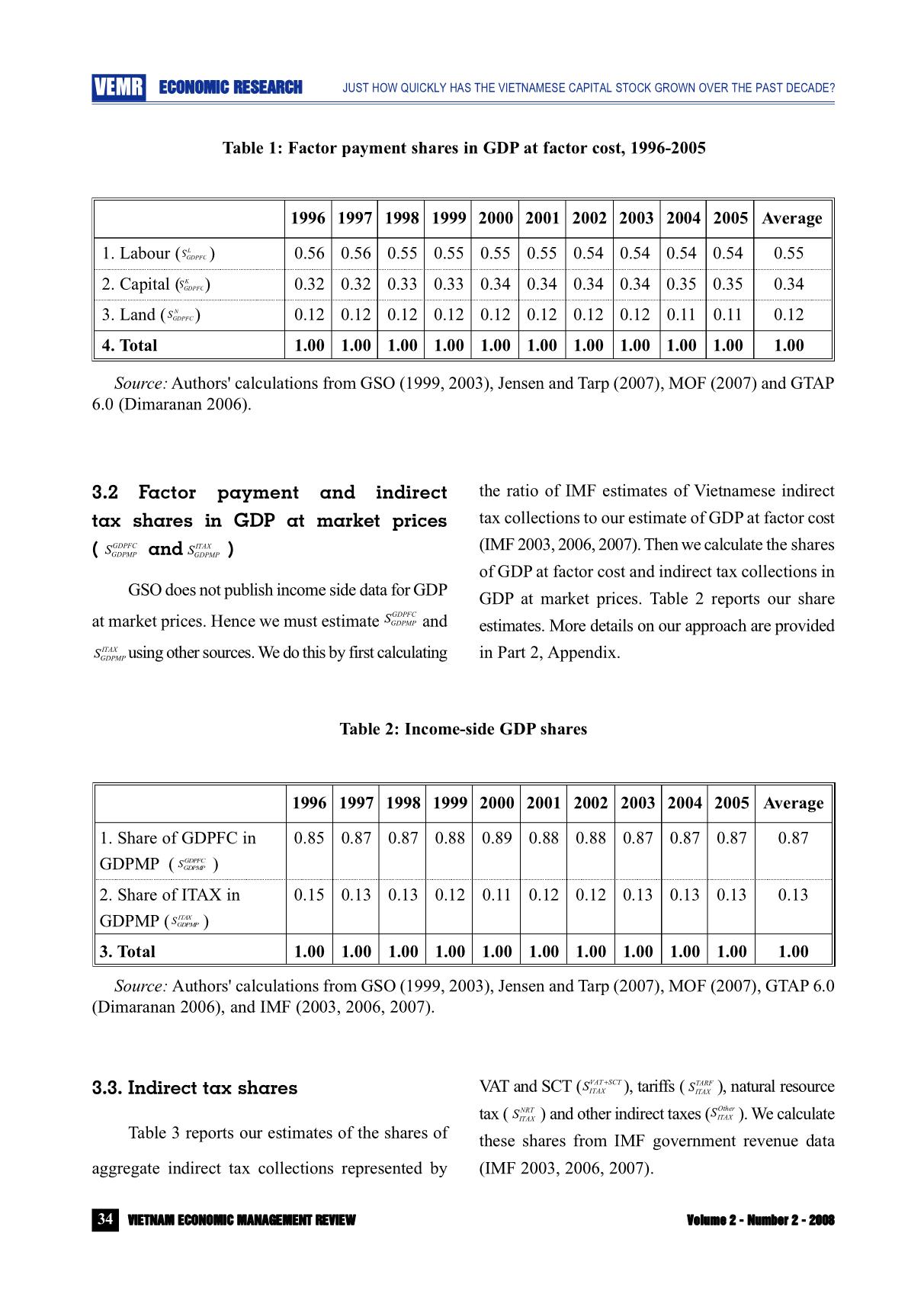
Trang 4
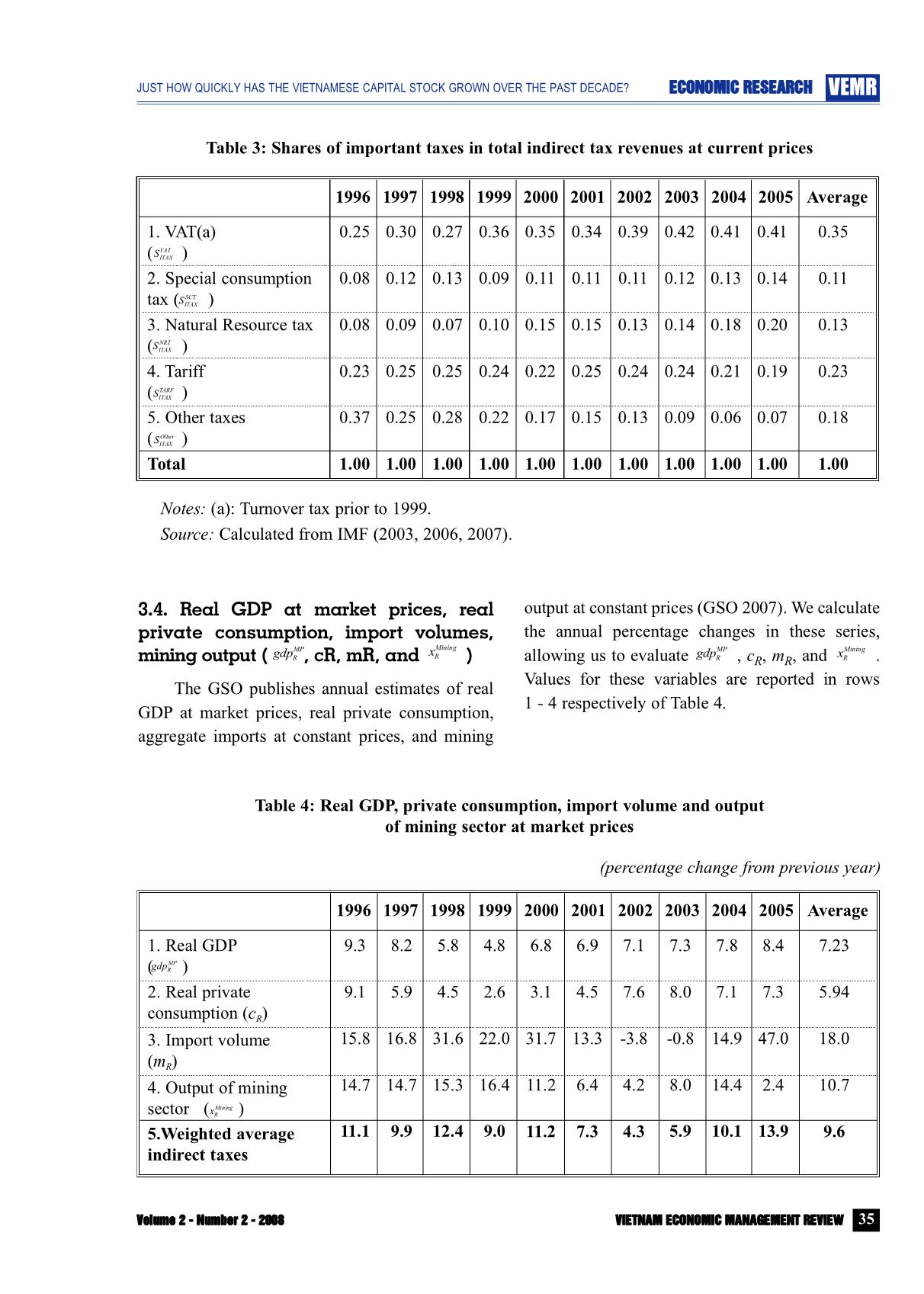
Trang 5
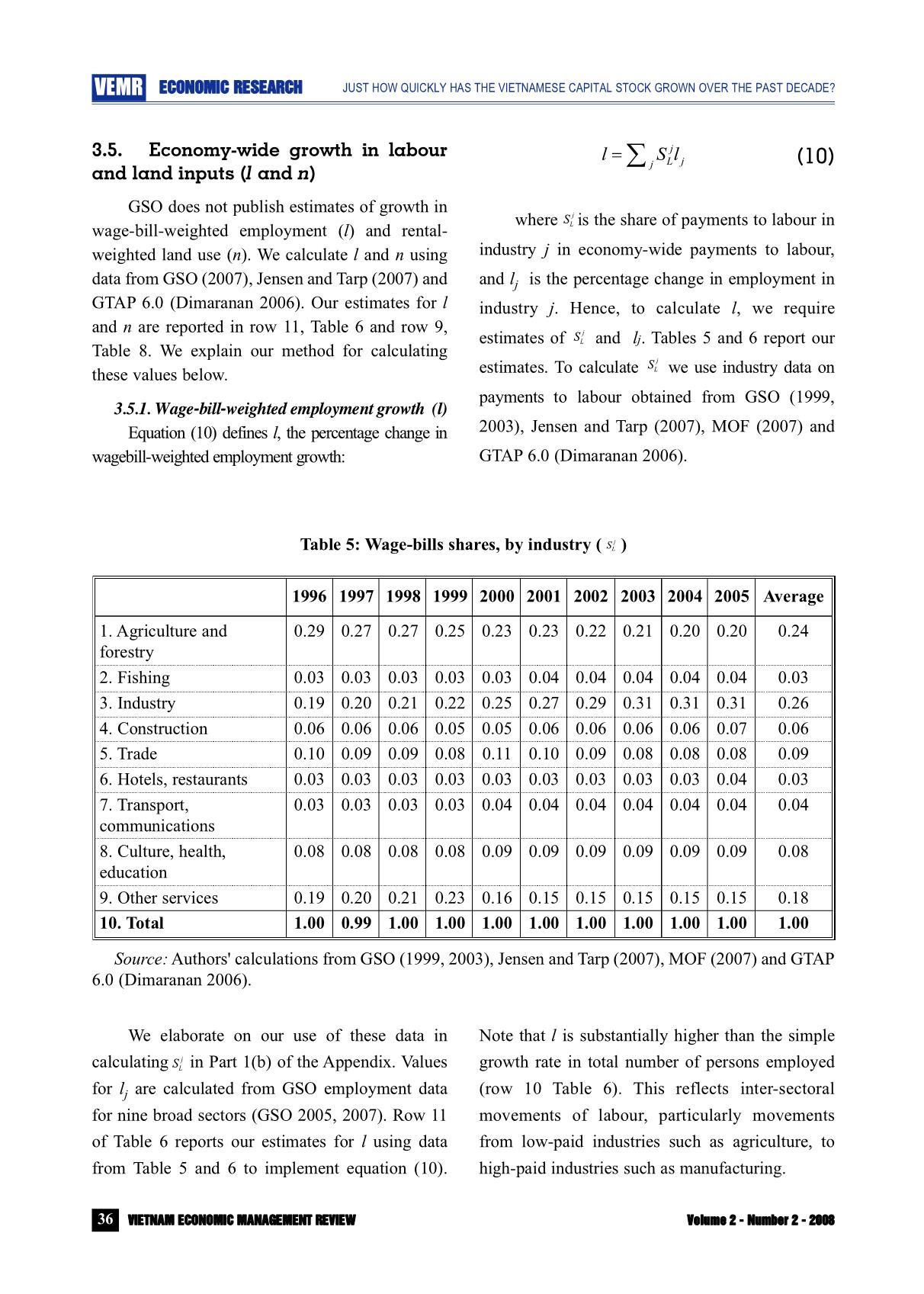
Trang 6
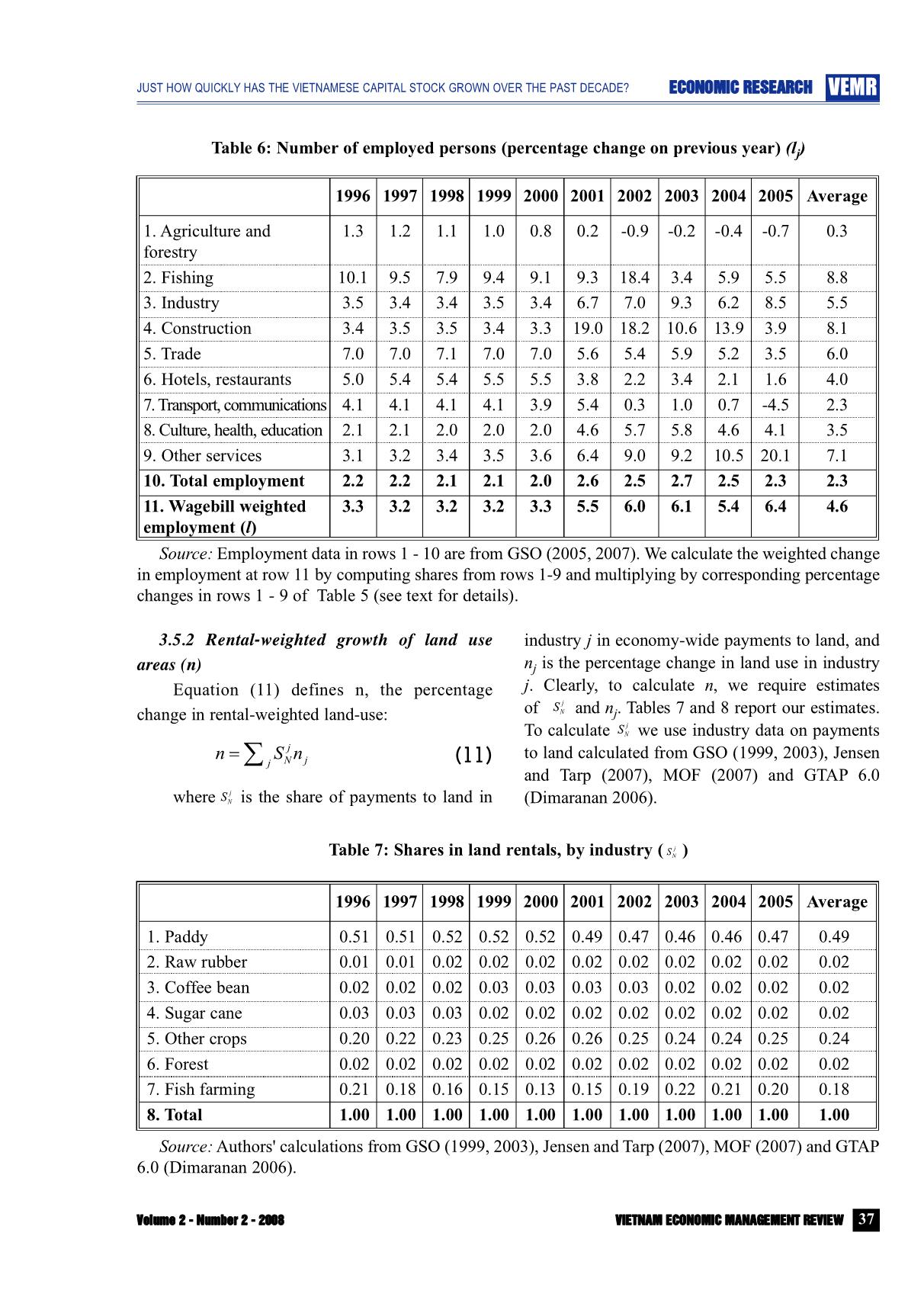
Trang 7
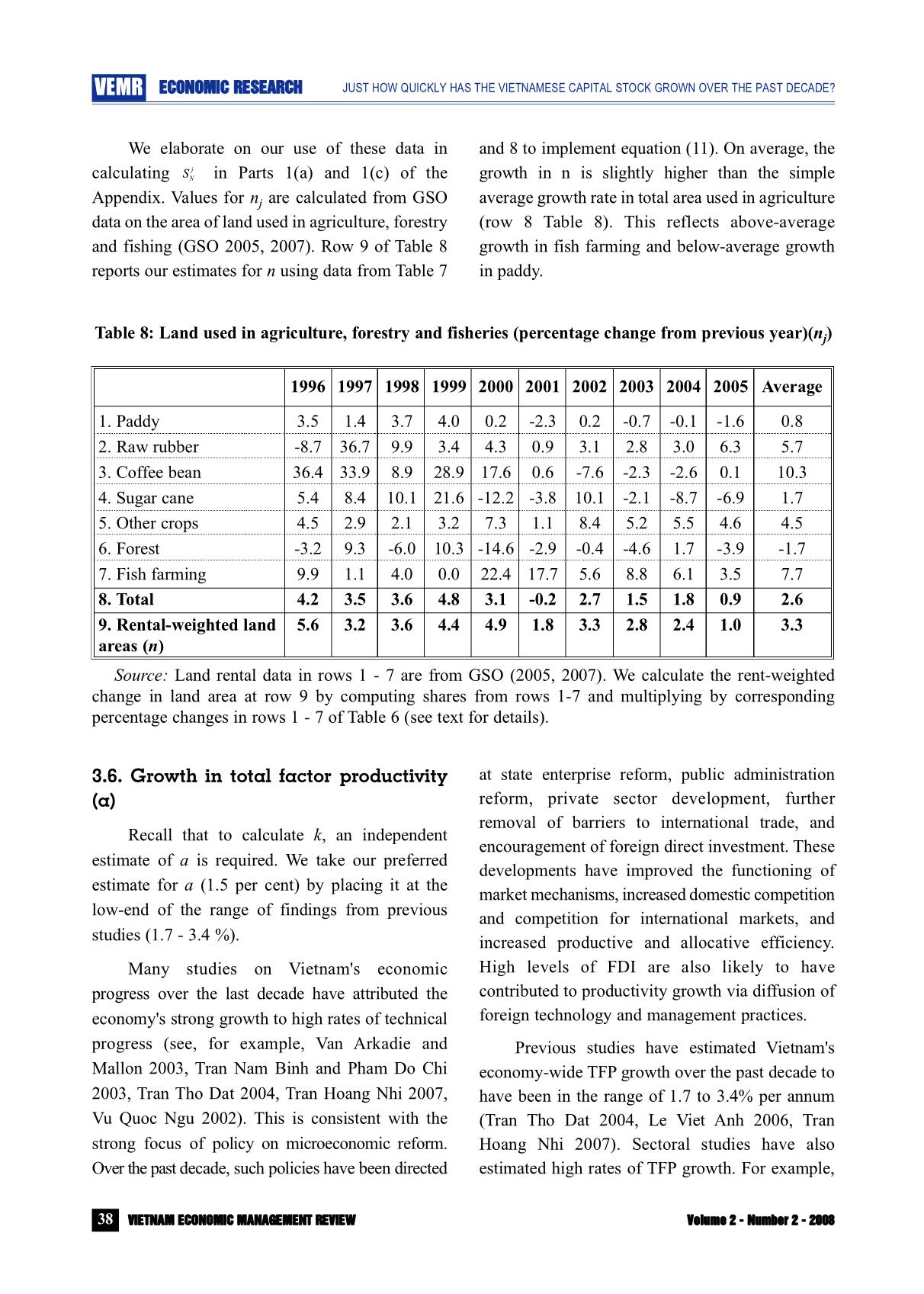
Trang 8
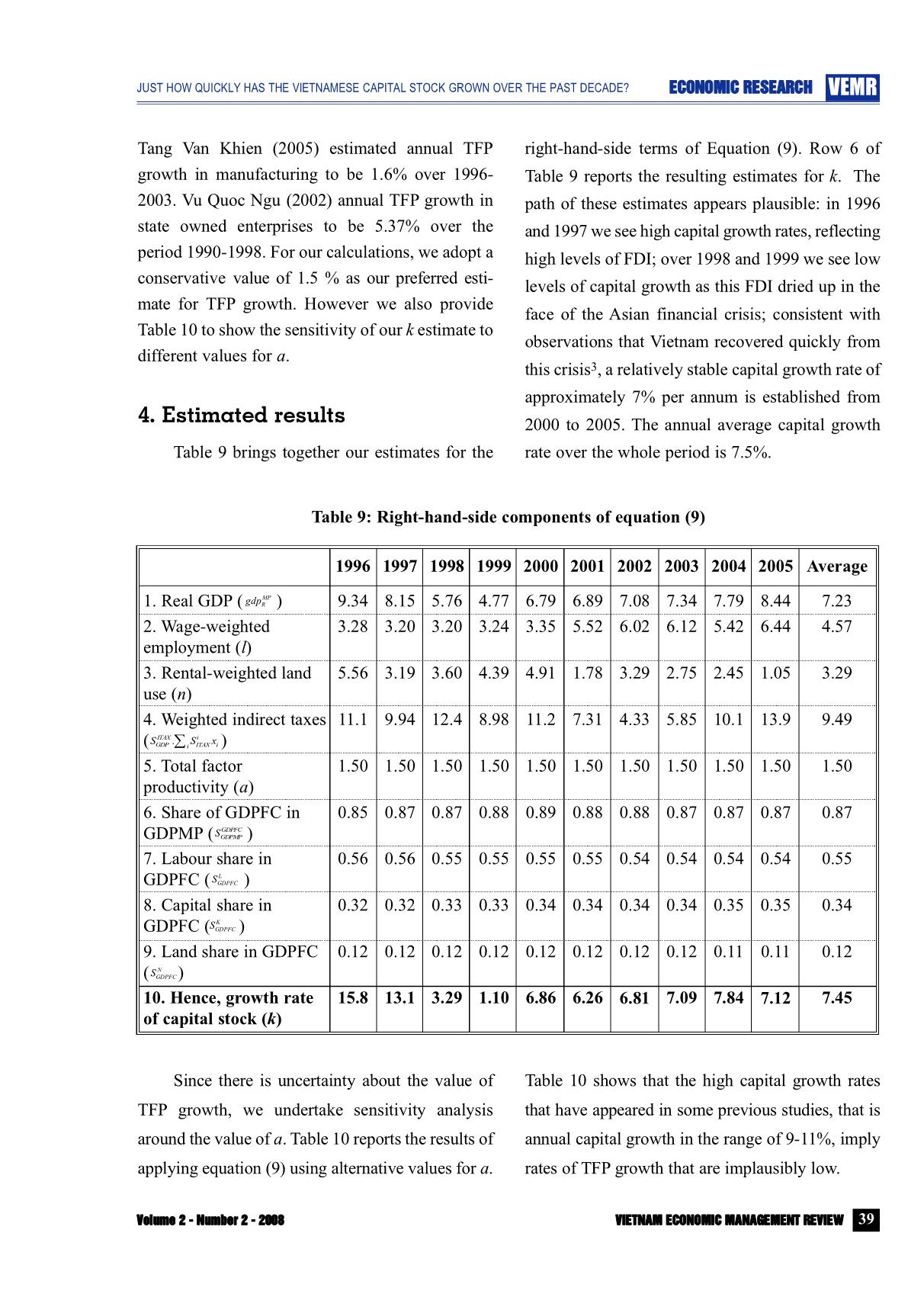
Trang 9
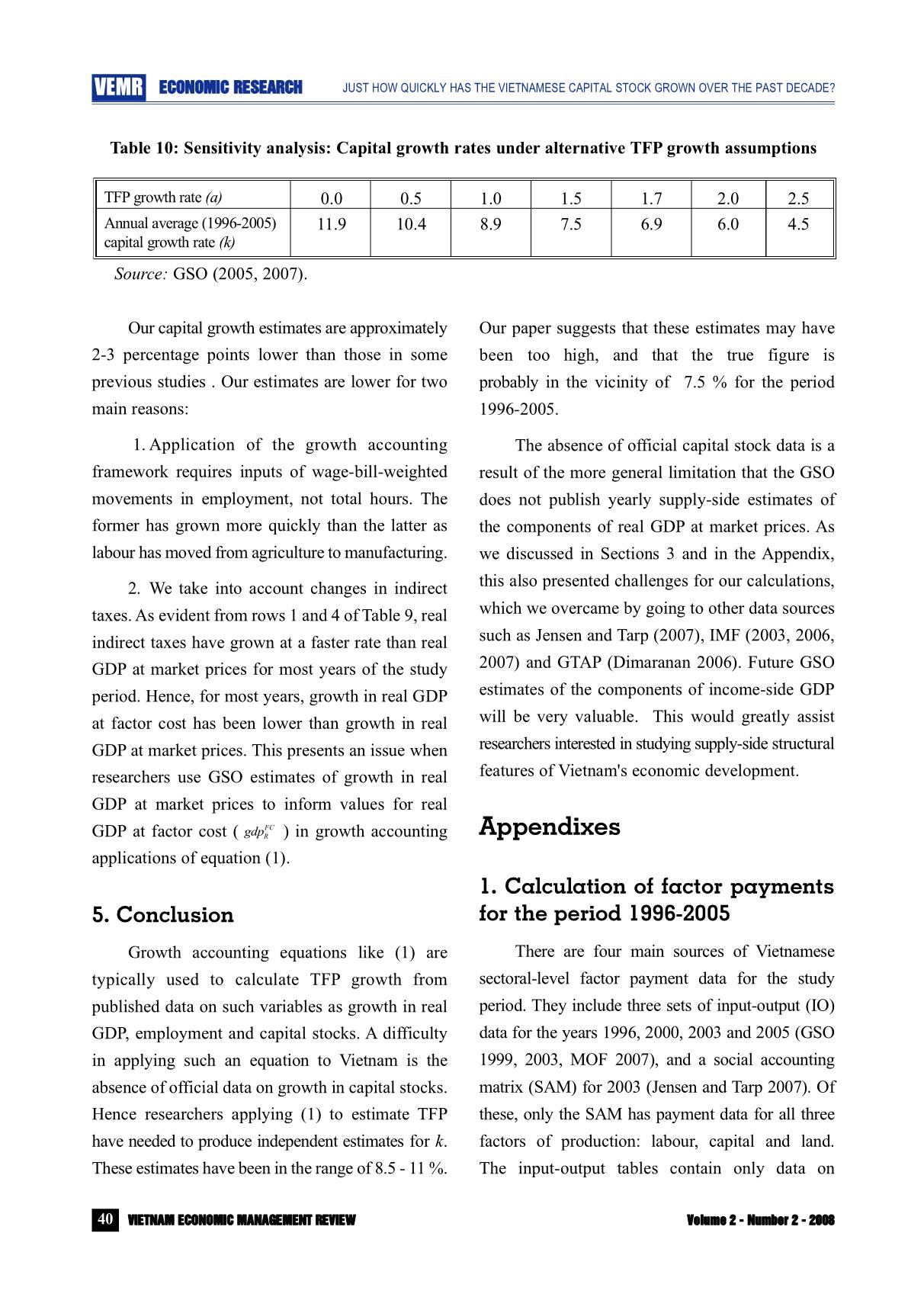
Trang 10
Tải về để xem bản đầy đủ
Bạn đang xem 10 trang mẫu của tài liệu "Just how quickly has the Vietnamese capital stock grown over the past decade ?", để tải tài liệu gốc về máy hãy click vào nút Download ở trên
Tóm tắt nội dung tài liệu: Just how quickly has the Vietnamese capital stock grown over the past decade ?
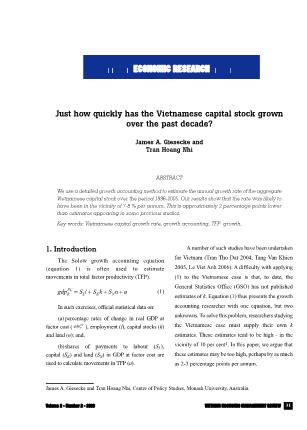
31Vietnam Economic management reviewVolume 2 - Number 2 - 2008 ECONOMIC RESEARCH 1. Introduction The Solow growth accounting equation (equation 1) is often used to estimate movements in total factor productivity (TFP). A number of such studies have been undertaken for Vietnam (Tran Tho Dat 2004, Tang Van Khien 2005, Le Viet Anh 2006). A difficulty with applying (1) to the Vietnamese case is that, to date, the General Statistics Office (GSO) has not published estimates of k. Equation (1) thus presents the growth accounting researcher with one equation, but two unknowns. To solve this problem, researchers studying the Vietnamese case must supply their own k estimates. These estimates tend to be high - in the vicinity of 10 per cent1. In this paper, we argue that these estimates may be too high, perhaps by as much as 2-3 percentage points per annum. Just how quickly has the Vietnamese capital stock grown over the past decade? James A. Giesecke and Tran Hoang Nhi James A. Giesecke and Tran Hoang Nhi, Centre of Policy Studies, Monash University, Australia. ABSTRACT We use a detailed growth accounting method to estimate the annual growth rate of the aggregate Vietnamese capital stock over the period 1996-2005. Our results show that the rate was likely to have been in the vicinity of 7-8 % per annum. This is approximately 2 percentage points lower than estimates appearing in some previous studies. Key words: Vietnamese capital growth rate, growth accounting, TFP growth. FC R L K Ngdp S l S k S n a= + + + (1) In such exercises, official statistical data on: (a) percentage rates of change in real GDP at factor cost ( ), employment (l), capital stocks (k) and land (n); and, (b)shares of payments to labour (SL), capital (SK) and land (SN) in GDP at factor cost are used to calculate movements in TFP (a). FC Rgdp PDF created with pdfFactory trial version www.pdffactory.com where is the percentage change in the GDP at market prices deflator; is the percentage change in real GDP at market prices; is the percentage change in the GDP at factor cost deflator; is the percentage change in real GDP at factor cost; xi is the percentage change in the quantity of activity i that is subject to indirect taxation; pi is the percentage change in the price of activity i; ti is the percentage change in the rate of indirect taxation of activity i). For growth accounting, (6) is the key equation. We focus first on the indirect tax term, . Movements in this term contribute to real GDP movements via allocative efficiency effects arising from the wedge that indirect taxes drive between values in use and values in supply for the activities i that are indirectly taxed. We do not have data on the billions of transactions that constitute i. Instead, we simplify by defining three broad sets of activities that are the major bases for Vietnamese indirect taxation, and a residual. The three broad activities are: (1) real private consumption, which where: is nominal GDP at market prices; is nominal GDP at factor cost; and is nominal collections of indirect tax revenue. We re-write (2) in terms of real variables and price indices as follows: VEMR ECONOMIC RESEARCH Just how quickly has the Vietnamese capital stock grown over the past decade? 32 Vietnam Economic management review Volume 2 - Number 2 - 2008 In this paper we provide annual estimates of the rate of growth of the aggregate Vietnamese capital stock over the period 1996-2005, using a detailed growth accounting framework. Our approach takes into account not only changes in aggregate inputs of labour and land, but also the effects of movements of these factors between sectors of the economy. Since GSO publishes data for real gross domestic production (GDP) at market prices, but not real GDP at factor cost, we must also account for movements in indirect taxes. We argue that the growth rate of the aggregate capital stock can only be in the vicinity of 10% if the rate of TFP growth is implausibly low (in the vicinity of 0.0 to 0.5 % per annum). If, as we suspect, annual TFP growth has been about 1.5 % per annum, then the average capital growth rate over the past decade has been about 7.5% per annum. 2. Methodology We begin with equation (2), the definition of nominal GDP at market prices: is the rate of indirect taxation on activity i; and, is the price of activity i. An example of activity i might be sales of imported five-seat-automobiles to households. According to the tax code in 2005, such a transaction attracts tariff at the rate at 100%, special consumption tax (SCT) at the rate of 80% and value added tax (VAT) at the rate of 10%. Dixon and Rimmer (2002, pp. 187-188 and 230-232) show that if the levels variables in (3) are interpreted as Divisia indexes, then (3) and its components have the percentage change forms: MP FCGDP GDP ITAX= + (2) . .MP MP FC FCGDP R GDP R i i iiP GDP P GDP X PT= + å (3) MPGDP FCGDP ITAX where: is real GDP at market prices; is the GDP at market prices deflator; is the GDP at factor cost deflator; is the quantity of activity i that is subject to indirect taxation; MP RGDP MP GDPP FC GDPP iX iT iP ( ) ( ) ( )MP MP MP FC FC FCGDP R GDP R i i i i iiGDP p gdp GDP p gdp X PT x p t+ = + + + +å (4) ( )MP GDPFC FC ITAX iGDP GDPMP GDP GDPMP ITAX i iip S p S S p t= + +å (5) . .MP GDPFC FC ITAX iR GDPMP R GDP ITAX iigdp S gdp S S x= + å (6) MP GDPp FC GDPp FC Rgdp .ITAX iGDP ITAX iiS S xå MP Rgdp PDF created with pdfFactory trial version www.pdffactory.com VEMRECONOMIC RESEARCH Just how quickly has the Vietnamese capital stock grown over the past decade? 33Vietnam Economic management reviewVolume 2 - Number 2 - 2008 is subject to Special Consumption Tax (SCT) and much of the incidence of Value Added Tax (VAT); (2) imports, which are subject to tariffs; and (3) natural resource extraction (ma ... 1996-2005 There are four main sources of Vietnamese sectoral-level factor payment data for the study period. They include three sets of input-output (IO) data for the years 1996, 2000, 2003 and 2005 (GSO 1999, 2003, MOF 2007), and a social accounting matrix (SAM) for 2003 (Jensen and Tarp 2007). Of these, only the SAM has payment data for all three factors of production: labour, capital and land. The input-output tables contain only data on Table 10: Sensitivity analysis: Capital growth rates under alternative TFP growth assumptions 2.0 6.0 1.7 6.9 1.5 7.5 1.0 8.9 0.5 10.4 0.0 11.9 2.5 4.5 TFP growth rate (a) Annual average (1996-2005) capital growth rate (k) Source: GSO (2005, 2007). FC Rgdp PDF created with pdfFactory trial version www.pdffactory.com VEMRECONOMIC RESEARCH Just how quickly has the Vietnamese capital stock grown over the past decade? payments to labour and capital. We explain below how we (a) calculate factor payment shares in the years for which we have data (1996, 2000, 2003 and 2005) and (b) estimate factor shares for the intervening years. 1 (a). Calculating factor payments in 1996, 2000, 2003 and 2005 Our first task is to calculate payments to land. Such payments are not explicitly recognised in the 1996, 2000 and 2005 databases. The main users of "land" (which we shall define to include agricultural land, water surface and returns to sub-soil assets) are agriculture, forestry, fishing, and mining. In the initial IO data, returns to land are spread among payments to labour and capital. Hence, factor payments in these sectors need to be reallocated to all three factors: labour, capital and land. SAM 2003 has data for land rentals in agricultural and forestry sectors. We use these 2003 factor payment shares to split total factor payment in the IO data for 1996, 2000 and 2005. Overall, land accounts for about 28% of factor payment in agricultural and forestry sectors. However, SAM 2003 does not contain estimates for the rental values of water rights used in fish farming, or returns to owners of natural resource concessions in mining industries. For these industries, we use factor payment shares from the GTAP 6.0 database for Vietnam . Overall, natural resources account for about 41 percent of total factor payments in the fishery and mining sectors. Combining our newly created factor payments data for agriculture, forestry, fishing, and mining with the factor payments data for all other industries in the available IO tables provides the economy-wide factor payments data for the years 1996, 2000, 2003 and 2005, which we highlight in Table A1. We explain in Parts 1(b) and 1(c) below how we calculate factor payments for the intervening years. 1(b). Sectoral shares in economy-wide payments to labour From the IO data for 1996, 2000, 2003 and 2005 we know sector-specific payments to labour. We reproduce these in Table A2, highlighting the years for which we have independent estimates. Our aim is to calculate sector-specific wagebills for the remaining years (1997-1999, 2001, 2002, and 2004). We do this in four steps. First, we estimate sector-specific wage rates for 1996, 2000, 2003 and 2005 by dividing the known sectoral wage-bills for these years by the known sectoral employment numbers for these years (GSO 2005, 2007). Second, we calculate year-on-year percentage changes in sector-specific wage rates for 1997- 1999, 2001, 2002 and 2004 by assuming that sector-specific wage rates grow smoothly between years for which we have wage-bill and employment data (1997-1999, 2001, 2002, and 2004). Third, we calculate year-on-year percentage changes in sectoral employment for all years between 1996 and 2005 using employment data from GSO (2005) and GSO (2007). Finally, we calculate sector-specific wage-bills for 1997-1999, 2001, 2002 and 2004 by applying our estimates of year-on-year percentage changes in employment and wage rates to the know wagebill data for 1996, 2000, 2003 and 2005. Table A1 reports the resulting sectoral wage-bills. The sectoral shares in economy-wide labour payments reported in Table 5 in the main body of the paper are calculated from Table A1. 41Vietnam Economic management reviewVolume 2 - Number 2 - 2008 PDF created with pdfFactory trial version www.pdffactory.com VEMR ECONOMIC RESEARCH Just how quickly has the Vietnamese capital stock grown over the past decade? 42 Vietnam Economic management review Volume 2 - Number 2 - 2008 1(c). Primary factor payments for the years 1997-1999, 2001, 2002 and 2004 Table A2 presents our factor payment estimates. As discussed above, data for the years 1996, 2000, 2003 and 2005 come either directly or indirectly from independent IO sources (GSO 1999, 2003, MOF 2007, Jensen and Tarp 2007, Dimaranan 2006). Wage-bill data for the intervening years come from our calculations outlined in Part 1(b) above. Payments to capital and land for the years for which we do not have independent data sources (1997, 1998, 1999, 2001, 2002 and 2004) are calculated by assuming smooth growth rates between the years for which we have factor payment estimates. We use the values in Table A2 to calculate the factor shares appearing in Table 1. Table A1: Wage bills, by industry (VND billion, current prices) Note: Highlighted columns show the values for which there are data. The remaining columns are extrapolated by the authors. Source: Authors' calculations from GSO (1999, 2003,. 2005, 2007), Jensen and Tarp (2007), MOF (2007) and GTAP 6.0 (Dimaranan 2006). Table A2: Factor payment at current prices (VND billion) Notes: Highlighted columns show the values for which there are data. The remaining columns are extrapolated by the authors. Source: Authors' calculations from GSO (1999, 2003), Jensen and Tarp (2007), MOF (2007) and GTAP 6.0 (Dimaranan 2006). 1996 1. Agriculture and forestry 2. Fishing 3. Industry 4. Construction 5. Trade 6. Hotels, restaurants 7. Transport, communications 8. Culture, health, education 9. Other services 10. Total 37,292 3,987 25,325 8,131 12,926 3,340 4,365 9,951 25,301 130,616 40,278 4,254 29,634 8,593 13,536 3,984 4,738 11,370 29,789 146,176 43,480 4,471 34,664 9,080 14,185 4,753 5,144 12,986 35,115 163,879 46,868 4,766 40,584 9,588 14,852 5,673 5,581 14,832 41,463 184,208 48,708 6,966 52,661 11,212 22,326 6,840 7,645 18,104 32,851 207,312 51,855 8,148 63,275 13,341 21,779 7,164 8,434 19,969 36,004 229,969 58,629 11,388 89,043 16,016 21,274 7,963 10,299 24,803 43,582 282,997 67,142 12,646 102,199 21,360 26,419 10,718 13,151 28,946 48,568 331,149 76,637 13,995 119,736 25,997 32,278 14,359 15,933 33,625 58,824 391,384 54,955 10,305 74,267 15,109 21,476 7,508 9,289 22,249 39,566 254,724 1997 1998 1999 2000 2001 2002 2003 2004 2005 1996 1. Labour 2. Capital 3. Land 4. GDPFC 130,616 73,526 28,312 232,453 146,176 84,352 31,580 262,109 163,879 96,773 35,226 295,878 184,208 111,022 39,292 334,522 207,312 127,370 43,828 378,510 229,969 142,737 48,705 421,411 282,997 179,259 60,145 522,402 331,149 212,278 68,764 612,191 391,384 251,379 78,618 721,381 254,724 159,959 54,123 468,807 1997 1998 1999 2000 2001 2002 2003 2004 2005 PDF created with pdfFactory trial version www.pdffactory.com VEMRECONOMIC RESEARCH Just how quickly has the Vietnamese capital stock grown over the past decade? 43Vietnam Economic management reviewVolume 2 - Number 2 - 2008 2. Indirect tax shares and GDP income-side shares Data on the collections of major indirect taxes for all years of the study period are available from IMF government revenue data (IMF 2003, 2006, 2007). We use the IMF classification of indirect taxes in all cases except natural resource tax. Whereas IMF considers revenue from natural resources a non-tax revenue, we treat it as an indirect tax, since it is levied on mining sector output. With this adjustment, we use the IMF data to calculate the indirect tax shares reported in Table 3. Our final task is to calculate the shares of GDP at factor cost and indirect taxes in income-side GDP ( and respectively). As discussed above, we know annual values for indirect tax collections ( ) from IMF data. From our calculations outlined in Part 1(c) of this Appendix we know annual values for GDP at factor cost ( ). We calculate annual values for and by applying the following formulae: 3. See, for example, Fforde (2001), Van Arkadie and Mallon (2003). 4. Indeed, if the high TFP rates used in the previous studies are taken into account, the difference between our k estimates and those of previous studies is even higher. For example, if annual TFP growth is 1.9% for the period 1996-2002 (as estimated in Le Viet Anh 2006) then our estimate for k for the same period is 6.3 %, not the 10% assumed by Anh. If annual TFP growth is 3.4% for the period 1996-2000 (as in Tran Tho Dat 2004) then our estimate for k for the same period is 2.1 %, not the 8.5 % assumed by Dat. 5. Hertel and Tsigas (2002) consider natural resources in fish- ery and mining as the fixed factors which constrain the price supply response of these sectors. With given econometric estimates of the supply elasticities for these sectors, they back-solve for the implicit natural resource payment shares. These form the basis of the factor shares for these industries appearing in the GTAP 6.0 database. References: n Central Institute for Economic Management (2003), Vietnam Economy in 2002, National Political Publisher, Hanoi. n Dapice, D. (2004), "Celebration and reflection: Vietnam's economy enters a new era", John F. Kennedy School of Government, Harvard University, Cambridge, [ accessed November 2007]. n Dimaranan, B. V. (2006), Global Trade, Assistance, and Production: The GTAP 6 Data Base, Centre for Global Trade Analysis, Purdue University, West Lafayette. n Forde, A. (c. 2001), "Light within the ASEAN gloom? The Vietnamese economy since the first Asian Economic Crisis (1997) and in the light of the 2001 downturn", Paper for the Vietnam Updates 2001: Governance in Vietnam: The Role of Organizations, Faculty of Arts and Social Sciences, National University of Singapore. n General Statistics Office of Vietnam (1999), The Vietnamese Input - Output Tables for 1996, Statistical Publishing House, Hanoi. n General Statistics Office of Vietnam (2003), The Vietnamese Input-Output Tables for 2000, Statistical Publishing House, Hanoi. ITAX GDPMPS GDPFC ITAX GDPMPS GDPFC GDPMPS GDPFC GDPMPS ITAX ITAX GDPMPS GDPFC GDPMPS GDPFC GDPMP GDPFCS GDPFC ITAX = + ITAX GDPMP ITAXS GDPFC ITAX = + and We report values for and in Table 2. r Notes: 1. The estimate for k for the whole economy is 10% per annum in Le Viet Anh (2006) for the period 1996-2002, and 10-11 percent for the period 2000-2004 in Dapice (2004). Tran Tho Dat (2004) estimates it to be 8.5%, but for the period 1996-2000, when Vietnam was affected by the Asian financial crisis. For the manufacturing sector, Tang Van Khien (2005) estimates k at 14.4% per annum for the period 1996-2003. 2. It has been argued by some researchers that this is indeed the case. See, for example, Dapice (2004) and CIEM (2003). PDF created with pdfFactory trial version www.pdffactory.com VEMR ECONOMIC RESEARCH Just how quickly has the Vietnamese capital stock grown over the past decade? n General Statistics Office of Vietnam (2005) "Statistical data", [ accessed February 2005]. n General Statistics Office of Vietnam (2007) "Statistical data", [ accessed November 2007]. n International Monetary Fund (2003), "Vietnam: Statistical Appendix", IMF Country Report No. 03/382, International Monetary Fund, Washington, D.C. [ nal/pubs/ft/scr/2003/cr03382.pdf, accessed April 2005]. n International Monetary Fund (2006), "Vietnam: Statistical Appendix", IMF Country Report No. 06/423, International Monetary Fund, Washington, D.C., retrieved August 2007, [ 06423.pdf, accessed August 2007]. n International Monetary Fund (2007), "Vietnam: Statistical Appendix", IMF Country Report 07/386, International Monetary Fund, Washington, D.C. [ nal/pubs/ft/scr/2007/cr07386.pdf, accessed January 2008]. n Jensen, H. T. and F. Tarp (2007), "A Vietnam Social Accounting Matrix (SAM) for the Year 2003", Discussion paper, PRG1.06.02, Central Institute of Economic Management, Hanoi. n Le, Viet Anh (2006), FDI-Growth Nexus in Vietnam Forum of International Development Studies, 31 (Feb. 2006), pp. 45-63. n Ministry of Finance (MOF) (2007), "Input- output tables for the year 2005", unpublished data, Policy Advisory Group, Ministry of Finance, Hanoi. n Tran, Hoang Nhi (2007), MONASH-VN: Development of a dynamic CGE model for the Vietnamese economy and analysis of structural changes during 1996-2003, Unpublished PhD thesis, Centre of Policy Studies, Monash University, Melbourne. n Tran, Tho Dat (2004), "Total Factor Productivity Growth: Survey Report - Vietnam", National Report, APO (Asian Productivity Organization), Tokyo. [ books/IS-04_TFPGrowth/13_Vietnam_TFP- .pdf, accessed January 2006]. n Van Arkadie, B. and R. Mallon (2003), Vietnam: A transition tiger?, Asia Pacific Press, Canberra. n Vu, Quoc Ngu (2002), "The State-Owned Enterprise Reform in Vietnam: Process and Achievements", Visiting Researchers Series, No. 4(2002), ISEAS (Institute of Southeast Asian Studies): 27, Singapore. 44 Vietnam Economic management review Volume 2 - Number 2 - 2008 PDF created with pdfFactory trial version www.pdffactory.com
File đính kèm:
 just_how_quickly_has_the_vietnamese_capital_stock_grown_over.pdf
just_how_quickly_has_the_vietnamese_capital_stock_grown_over.pdf

